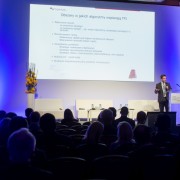Trends in Asset Management
Trends in Asset Management
Asset managers face an existential crisis as they confront the ending of a six-year rise in asset prices. What does the future hold for the sector? Christopher O’Dea inquires
The main trends affecting the asset management industry now contain existential challenges to core investment theory and the business model. Rising asset prices since the monetary crisis have helped asset managers to maintain gross profits despite the shift to low-cost investment strategies and product alternatives. But that tailwind has subsided, leaving asset management firms in the doldrums as storm clouds gather – increasing customer demand for lower fees, new regulation, and closer examination of the social worth of the investment management business itself.
At a glance
• Asset management firms face more dangers with their company.
• Downward pressure on fees has become persistent.
• Americans are asking why there are numerous pension funding shortfalls at defined benefit plans and such modest balances among defined contribution plans.
• Digital capabilities are getting to be more common but the human touch will remain essential.
In a nutshell, threats are rising – not merely threats to the worth of securities in portfolios of investment management companies, but risks to the companies themselves. Now, asset managers are grappling with those threats, which promise to bring technology that is new, reduced employment, lower earnings, and a heightened focus on producing sustainable returns instead of the historic chase for above-market performance.
“The six-year tailwind to asset managers from asset inflation seems to be over,” according to some report on European asset managers by Goldman Sachs International released in April. “ asset inflation, rather than flows drove More than 70% of this,” Goldman says. “This tailwind is at an end, replaced by a more explosive, less directional market backdrop.” In reality, the global investment management business is entering a period of consolidation and reorganisation, setting the stage for what Tim Hodgson, head of the Willis Towers WatsonThinking Ahead Institute calls “necessary re-invention”.
Business model under duress
The starting point for a re-invention is that downward fee pressure a regular feature of the business – is becoming constant. Which will lead to a revenue pool that is shrinking, as customers act on the belief, however well grounded, that active supervisors supply no net value. Hints of that can be seen, as recent growth in business revenue and profits has resulted chiefly from asset-price inflation as opposed to net new AUM. That situation highlights the crux of the issue – the industry is set up to benefit asset managers and related intermediaries, not asset owners and pension plan members.
“we’re interested in the behavior of the investment system,” says Hodgson. “ there are issues out there that are bigger in relation to the asset managers, and Asset managers are part of the system.” Over recent years, the Thinking Ahead team has developed the view that the best means to discern what is for asset managers is to follow the money”. Following that trail leads to the conclusion the investment management sector has a fundamental issue – it is create mainly to help industry providers. In a 2014 survey, Thinking Ahead found that only 42% of industry participants agreed that the industry is primarily designed to help the members rather compared to the agents working within it. In a report on the study, Hodgson wrote: “For a properly configured, customer-focused business, 90% of participants would not be unable to agree with such a statement.”
The result is that too much of the $100trn (€87trn) in capital invested internationally in bonds and fixed income securities is regularly transferred to asset managers and intermediaries in the form of fees predicated on the value of those assets. Asset management pays high wages to stockholders to high margins and employees, Hodgson says to other sectors like food retailing that pay low margins and low wages. The asset management industry is extracting “ rents that are excessive ”, he says.
But asset managers expend tremendous effort transferring securities among themselves in an attempt to have the highest-priced securities in the funds they handle. The exercise doesn’t increase the aggregate value of the international portfolio – for trying to conquer their peers but substantial fees charge.
The value thus transferred from portfolios to asset manager accounts is not insignificant. And BCG says net revenue growth slowed from 9% in 2013 to 7% in 2014 owing to fee pressure and the shift from traditional actively managed products to passive strategies, alternatives such as for example liability-driven investment and target-date funds, and speciality strategies.
Engine needs repair
Managers have responded with several alternative approaches to asset allocation and portfolio construction, including factor investing, smart beta investing and hazard parity. Each has its edges, and put together they’ve helped the asset management sector move to a world of lower-cost investing that targets delivering outcomes that are specific as opposed to attempting to assemble a bundle of securities that create a yield rather better than the usual market index.
Non-traditional strategies are anticipated to pull most new assets in the years ahead. Equity research businesses that are several view BlackRock as the greatest example of where investment management is heading. “BlackRock stays the greatest increase narrative in asset management, with numerous tailwinds supporting its superior P/E ratio and organic fee growth according to a Goldman Sachs report on the company before in 2013, in our view.
From supervision to transformation
While asset managers revamp themselves, regulators are shifting their own assignment from supervision to transforming the US investment industry in the exterior in.
That index is predicted by an analysis of the final rules by Morningstar and exchanged -traded product providers will get an additional increase; the effect on asset managers that are active will be combined; and some alternate asset managers will face new challenges. The final rules dropped an earlier list of permitted assets excluding some alternatives. But advisors will still be required to justify using choices, which usually charge fees that are relatively high, and Morningstar anticipates advisors will be “leery of using high-fee products, when under a fiduciary duty” even if they permitted.
That is another question mark by hedge funds on choices at a time of poor performance. “Any institutional investor allocating to hedge funds is examining the recent performance period attentively, ” says Lightyear’s Marrron. They may be looking to answer one question: “Whether the hedge fund model, when it comes to the fees which might be billed, is consistent with the functionality that is available.”
Under pressure: five dilemmas faced by asset managers
Business model under duress – changing the beneficiary designation
• Fee pressure is relentless and shrinking the earnings pool, likely for good.
Supervisors that are • supply no net worth and growth comes from asset-price inflation not new AUM.
• The crux of the issue is that the investment industry structure is create to help asset owners and intermediaries, not beneficiaries and asset managers.
Relationship matters – winning and retaining clients
• Customer experience/understanding the individual touch is vital. Presentation and persuasion skills are more crucial than ever and the role of consultants increase.
• But for institutional managers in the new universe – it’s about execution for productivity increases, marketing effectiveness and jobs that are moving to lower-cost locations.
The regulator’s efforts to reshape the US individual retirement investing marketplace pat into societal questions about the worth of investment managers. The conventional wisdom in the US to ask why, if the business is so successful, there are a lot of pension funding shortfalls at defined benefit (DB) plans, and such little balances in the defined contribution (DC) accounts of the majority of Americans. On increasing the collective yield accessible to investors that own securities in a sustainable way but the assignment of investment management is being refocused.
Hodgson suggests replacing fees with a flat fee arrangement in which investors purchase a slice of a supervisor’s capacity as a proportion of asset values. Managers might find this arrangement appealing in light of long-term strength flows. Assets in DB plans are flowing out of the sector as strategies go into net distribution status, and the contribution rates of new DC plans are not too high to create offsetting asset inflows, he explains.
And the prospect of flat equity returns and falling bond prices means supervisors will not manage to rely on asset price inflation to boost revenue and profits. BCG reports that in 2014, institutionally – assets increased by just 8% and revenues by only 3% – while their gains shrank 1%.
Technology –
Nowadays industries look to technology as a way to reduce costs. In asset management, technology has made considerable cost savings through operational improvements and outsourcing back office functions. Now technology has been used in two new areas – client relationships and the investment procedure.
Worldwide asset servicer State Street plans to reflect new light on the digital files associated with the group’s $27trn of customer assets. The goal will be to use data analytics to glean new, real time insights from the transaction data and other information in its computer systems. State Street’s previous technology initiative reduced costs by $625m through a personal cloud and automation of procedures that resulted in 4,000 job cuts.
Analysts view the new programme with cautious optimism. State Street faces pressure on its net interest margin, and although the sales opportunity is vague”, Goldman says “we see value in this kind of innovation for State Street’s customers”.
Relationship matters
Whatever their product focus, asset managers now face a future in which attaining growth will require companies to differentiate themselves by showing value through pricing, sales activity and marketing campaigns. Oftentimes, says BCG, “winning supervisors will gain edge by developing and deploying sophisticated capabilities in data driven decision-making”.
While digital capabilities are getting to be essential to compete in 21st-century asset management, for institutionally-driven supervisors the individual touch will remain – and maybe take on more significance.
New research from Greenwich Associates demonstrates that topnotch persuasion and presentation skills will be more critical than ever for investment managers seeking to build relationships with advisers, who are tightening their management of institutional assets.
Formal meetings with investment advisers are frequently make or break occasions Greenwich says, for asset managers, as 86% and 92% of institutional investor relationships are intermediated by advisers in UK and the US .
European asset managers may have a story to tell that would make any investment team welcome in a consultancy conference room.
A Goldman analysis of Lipper fund data indicates that 65% of European equity funds benchmarked against the Stoxx 600 outperformed in 2015, and through early April fund managers quantified against the Stoxx 50 index revealed a talent for creating alpha software, with 76% posting above-standard performance.
Performance like that just might reinvigorate active management – and put back the wind in asset managers’ sails in the procedure.






